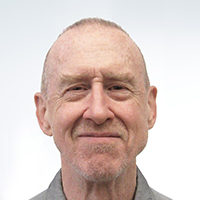
William Forsythe
2024 Kyoto Prize Laureates
Theater, Cinema
/ Choreographer
1949 -
2024
11 /11 Mon
13:00 - 16:10
Place:Kyoto International Conference Center
Capacity:1,500 persons (FCFS)
Admission Free
William Forsythe’s deep engagement with the vocabulary, structures and norms of traditional ballet has widened perception, expanded practice, and reshaped expectations for the future of the art form. His transformative approach to the grammatical logic of the métier’s practices is an inquiry into the emergence of meaning through the practice of physical organization.
William Forsythe’s deep engagement with the vocabulary, structures and norms of traditional ballet has widened perception, expanded practice, and reshaped expectations for the future of the art form.
Forsythe, born in 1949 in Long Island, New York, studied ballet at Jacksonville University in Florida and subsequently worked with the Joffrey Ballet in New York. He then joined the Stuttgart Ballet in Germany in 1973. While performing as a dancer there, Forsythe created his first professional choreographic work, Urlicht, in 1976. During his 20-year tenure as director of the Ballet Frankfurt, beginning in 1984, Forsythe created an extensive repertoire of genre-defying choreographic works that permanently altered the landscape of ballet. While encouraging ballet dancers to attenuate the academic physicality of their training, he also invited a layering of self-determined, flexible timings within the dense counterpoint of his choreographic structures, offering a wide distribution of autonomous decision-making processes. This reconfiguration of the historical social contract between ballet dancer and choreographer was registered throughout the field. In 2004, he founded a new ensemble, The Forsythe Company, where through 2015, he continued to pursue the potentiality of the art form. Forsythe, now based in Germany and the United States, has been active in creating ballet, dance, and installations worldwide.
Forsythe’s innovation has been to relentlessly question the array of mechanisms that underlie the genre of classical ballet, interrogating aspects of performance that had previously been assumed to be self-evident. The first striking example was the repeated, abrupt falls of the stage curtain which interrupted his 1984 production of Artifact. These curtain falls were timed to coincide with the musical chapters of Bach’s D-minor Chaconne, allowing for entirely new visual episodes to be established when the curtain rose again. This dynamic interruption of the historical performance format deeply disconcerted those viewers entrenched in the structures of 19th century ballet classicism, while also providing a mesmerizing suite of novel visual confrontations. The relentless waves of change crashed over the audience and alerted them that an era of a new order was imminent.
Forsythe’s research created an environment enabling dancers themselves to explode the spatial framework that had been the defining physical limit for classical ballet. For example, in In the Middle, Somewhat Elevated (1987), originally created for the Paris Opera Ballet, the choreography made use of academic virtuosity, while drastically extending and accelerating its figures to achieve a new and thrilling kinetic aesthetic.
Deeply interested in the principles of choreography itself, Forsythe pioneered a stunning methodology Improvisation Technologies. A Tool for the Analytical Dance Eye (1994, 1999), to expand the potential for analyzing improvisational action. Through the lens of ballet’s geometric inscriptive language, he illuminated the dancer’s embodied graphic intention with the groundbreaking use of digital animation.
Another distinct branch of inquiry is Forsythe’s Choreographic Objects, which are addressed to non-professional participants. By engaging with these objects, the participants physically experience categories of choreographic outcome that would otherwise be unavailable to them. These works appear primarily in museum contexts. Examples include Nowhere and Everywhere at the Same Time No. 2 (2013), a room where hundreds of automated pendulums swing from the ceiling, determining a choreographic script in which visitors partake. In Black Flags (2014), two pre-programmed industrial robots manipulate immense black flags in a complex contrapuntal choreography that would be beyond human capabilities to perform.
Within Western Art, contemporary choreographic practices are notable for how they respond to evolving ideas about the body and physical experience, often engaging in broader cultural shifts that challenge traditional artistic frameworks. Forsythe has been at the cutting edge of this movement for almost 50 years, and the fundamental impact of his achievements will resonate far into the future.
For these reasons, the Inamori Foundation is pleased to present the 2024 Kyoto Prize in Arts and Philosophy to William Forsythe.
Profile is at the time of the award.